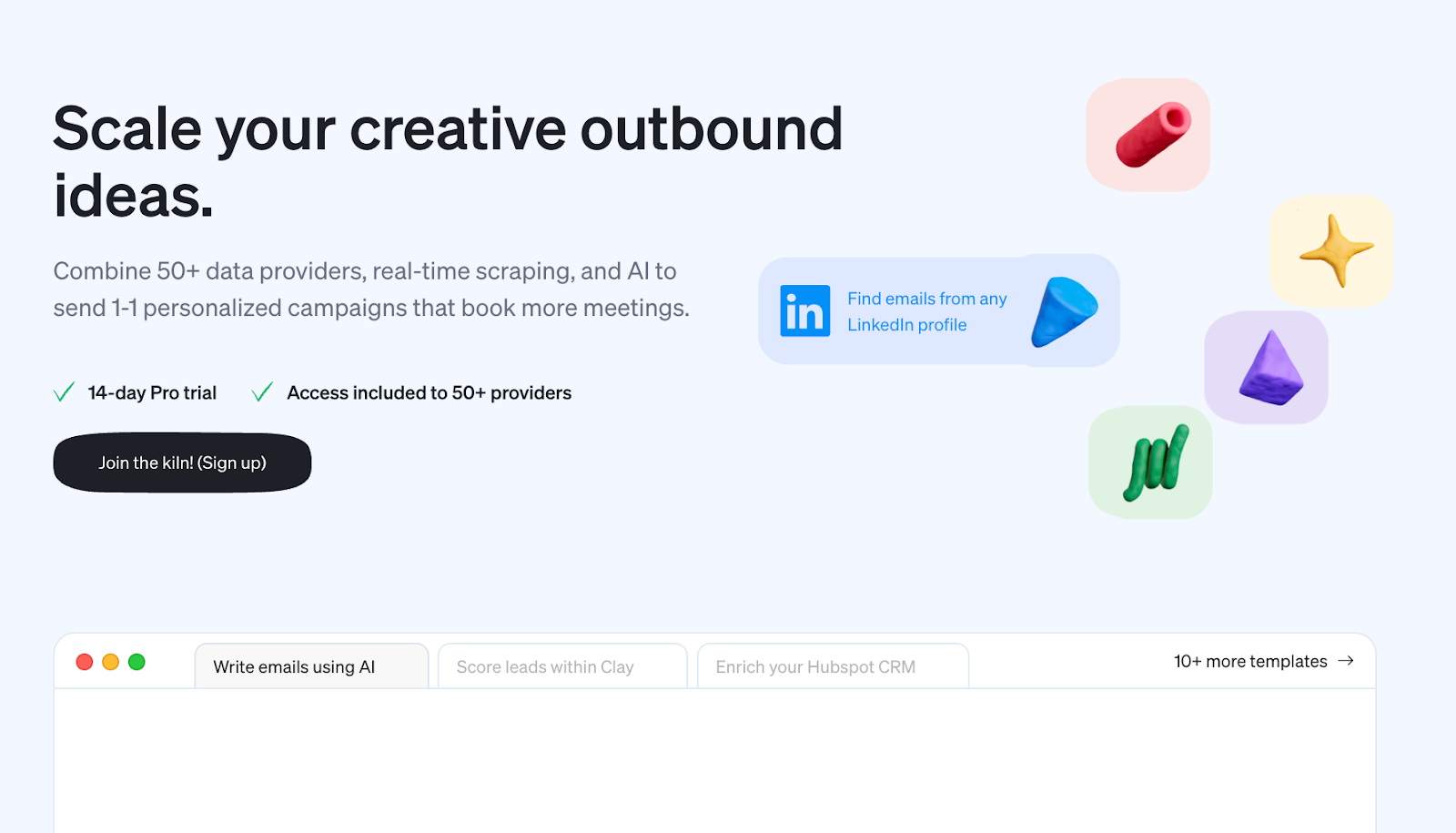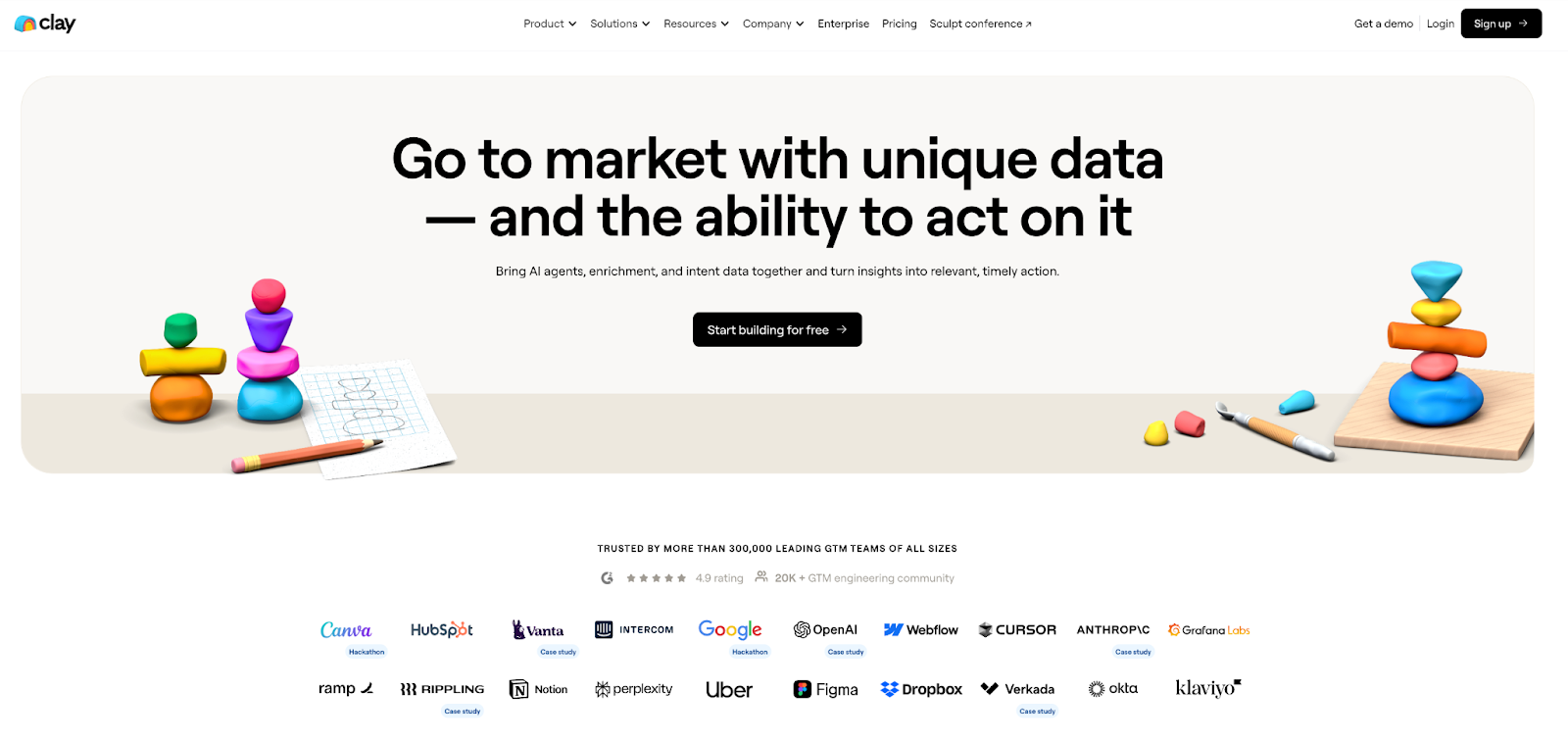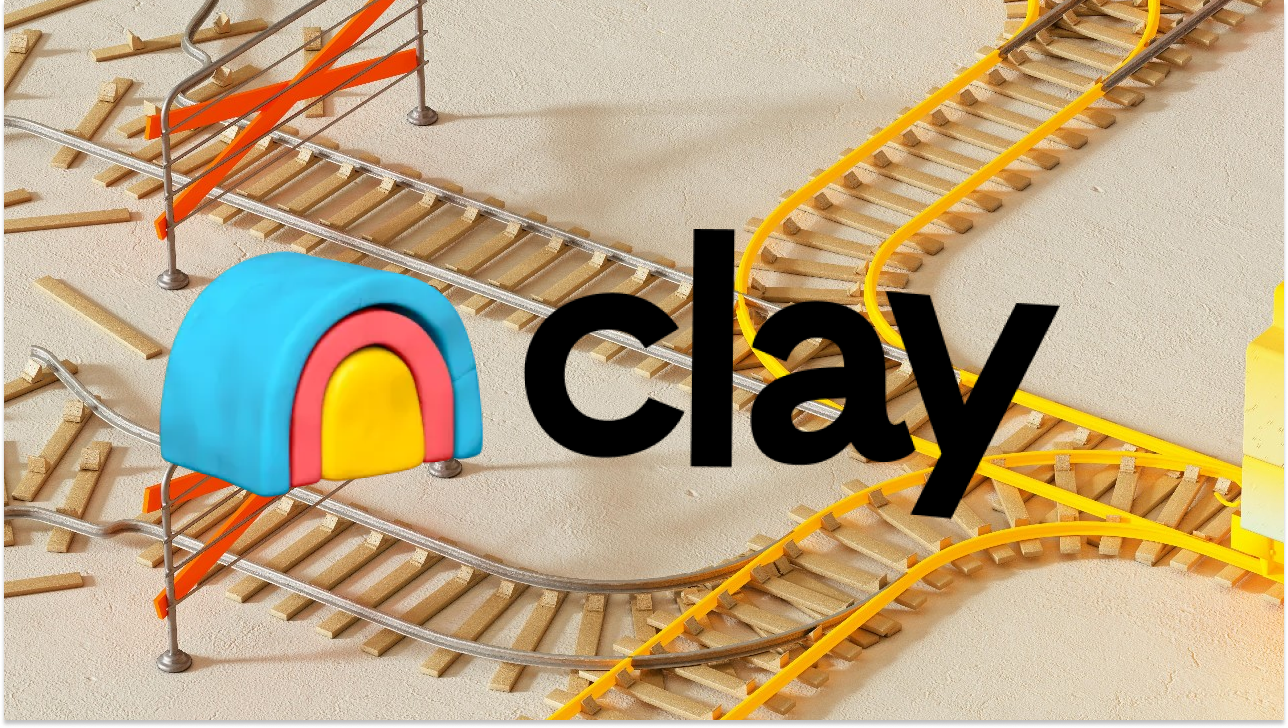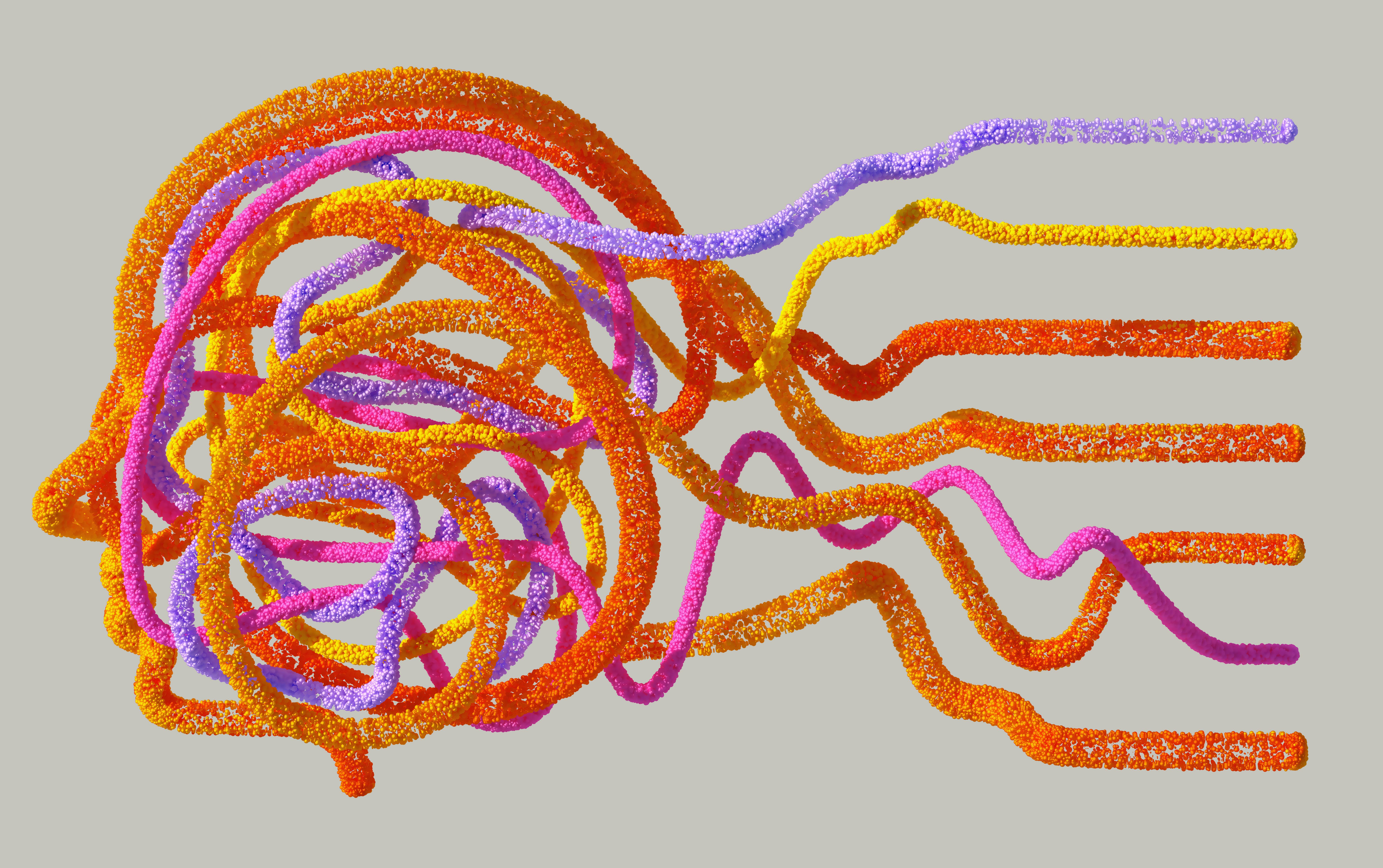TL;DR
- Five years of “everything for everyone” messaging delivered one outcome: ~20 customers.
- In 2022, Clay focused its messaging on sales teams with “Find perfect leads,” and that clarity unlocked 10x growth and wider adoption.
- By 2025, Clay stopped selling features and launched the “GTM Engineer” role, creating a category that positioned them as the market leader.
Clay spent five years of trial and error before a January 2022 pivot transformed it from a general spreadsheet tool into a go-to-market platform, with AI propelling it to a $3.1 billion unicorn [1]. The company's homepage positioning evolved through three distinct eras: Spreadsheet (2017-2021), Data Enrichment (2022-2023), and AI Agents (2023-present). Each reflecting fundamental shifts in strategy, customer focus, and market timing.
Between 2017 and 2025, Clay’s messaging and landing pages changed 25+ times, and we tracked every pivot and tweak [4]. From cryptic questions to category ownership, each message revealed Clay's evolving understanding of their market. Here are the five most critical messaging moments that transformed a wandering startup into a category creator.
November 2020
"Build tools & workflows to supercharge your team."

Three years after launch, Clay was stuck in “the spiral,” as CEO Kareem Amin put it, bouncing between salespeople and recruiters, lost in its own loop of confusion [2].
Their ~20 customers used Clay for wildly different things. One for accounting software. Another for recruiting. Several for sales. Amin's painful admission: "People would feel excited by the possibilities but wouldn't return to use it consistently" [2].
The homepage copy revealed the problem.
- "Build tools" - what tools?
- "Workflows" - which workflows?
- "Your team" - what team? Sales? Marketing? Engineering?
The message could apply to Notion, Airtable, Monday.com, or a hundred other tools. When your messaging fits everyone, it resonates with no one.
The product had infinite potential and zero focus. Despite raising from tier-one VCs, they had little revenue.
October 2022
“Get creative finding customers.”

This message marked a new era for Clay. The breakthrough came from Varun Anand, who joined as an advisor in October 2021. He actually talked to real customers and prospects, uncovering a need from email agencies managing multiple clients with identical challenges [2].
January 2022: Clay made the hardest decision. Focus exclusively on GTM teams. Amin later admitted:
"I had hangups about committing to being just a go-to-market tool... I had to teach myself that just because we're closing other avenues for now doesn't mean we won't get back to them later" [2].
Revenue grew 10x that year. The Slack community exploded from 200 to 10,000+ members [1].
October 2023
"Scale your creative outbound ideas."

Clay launched Claygent, their AI research agent, in September 2023, perfectly timed to ride GPT-4’s reliability [1]. While competitors offered static data points, Claygent answered custom questions: Does this company mention SOC-2? What pain points appear in their blog posts? Companies like Intercom use Claygent to discover unconventional buying signals, patterns no traditional database would capture. For example, one Clay customer discovered that companies mentioning specific employee benefits correlate with higher support tool adoption [1].
Claygent turned insights into action, a promise reflected in their homepage messaging: empowering teams to “scale creative outbound ideas.” By mid-2024, 30% of customers used it daily, running 500,000 research tasks per day. By June 2025, it had surpassed 1 billion runs, fueling smarter, hyper-targeted campaigns at scale [1].
June 2024
"Scale personalized outreach with better data enrichment."

The message shifted from finding leads to personalizing outreach. "Scale" and "personalized" are usually on opposite ends of the spectrum but Clay claimed you could have both. This wasn't about data anymore. This was about what you could do with data.
This shift reflected Clay's real breakthrough: creating the "GTM Engineer." They realized their users weren't traditional sales ops people clicking through UIs. They were technical builders creating sophisticated workflows. So Clay gave them an industry title.
By naming their users, Clay transformed from a tool into an identity. The homepage copy wasn't just selling software anymore.
September 2025
"Go to market with unique data and the ability to act on it."

Today's homepage shows total confidence. No competitors mentioned. No features explained. Clay is the category.
The numbers tell the story: 280+ companies posting GTM Engineer roles. Seven bootcamps graduating 2,500+ students. 108 agencies worldwide building businesses on Clay. 15,000+ members in their Slack community. Companies like OpenAI, Cursor, and Webflow are hiring for a job Clay invented [3].
Clay's valuation soared from $500 million in June 2024 to $3.1 billion by August 2025, a 6x increase in 14 months. The August 2025 Series C, led by Alphabet's CapitalG, valued them higher than many public SaaS companies [3].
The pattern
Five messages. Seven years. Three levels of messaging maturity.
Level 1: Feature-first (2017-2021)
"Build tools & workflows." / "This spreadsheet fills itself."
Trying to explain what the product does. Twenty customers doing twenty different things. Near-zero revenue despite $16M raised. The classic founder mistake: assuming features create desire.
Level 2: Benefit-focused (2022-2023)
"Find perfect leads." / "Enrich your CRM. Close more deals."
Finally explaining what the product does for you. Customer problems instead of product capabilities. 10x growth two years straight. The messaging evolved from "here's what we built" to "here's what you'll achieve."
Level 3: Category creation (2024-present)
"Go to market with unique data and the ability to act on it."
No longer selling software, selling a new way of working. Created the GTM Engineer profession. Manufactured demand by naming the transformation. The messaging transcended the product entirely.
Most startups get stuck at Level 1, listing features nobody asked for. Some reach Level 2, connecting to real customer outcomes. Only the rarest few achieve Level 3, defining not just what customers do, but who they become.
Clay didn't just pivot to sales teams. They invented a professional identity that made their tool inevitable. By August 2025, OpenAI and Cursor were hiring for positions Clay had manifested into existence. Seven bootcamps were training people for a job that didn't exist when Clay started.
The brilliance wasn't in finding product-market fit. It was in creating market-product fit by inventing the market itself. They built a category so specific that they became its only logical winner.
That's how you turn five homepage messages into three billion dollars.
Frequently asked questions
Q: How long did it take Clay to find product-market fit?
Clay took five years (2017-2022) to find product-market fit. Despite raising $16M from top-tier VCs like Sequoia and First Round, they had only ~20 customers paying $30-200/month before their January 2022 pivot to focus exclusively on sales teams.
Q: What was Clay's biggest positioning mistake?
Trying to serve everyone. Their November 2020 message "Build tools & workflows to supercharge your team" could have described Notion, Airtable, or dozens of other tools. When your messaging fits everyone, it resonates with no one.
Q: What triggered Clay's 10x growth?
The January 2022 decision to focus exclusively on GTM teams, specifically cold email agencies. This came after Varun Anand joined and did customer discovery in the Modern Sales Pros community, learning what these teams actually needed.
Q: What is a GTM Engineer?
A role Clay invented in 2024 for professionals who combine technical skills, data fluency, and business acumen to build automated revenue systems. By August 2025, there were 280+ GTM Engineer job postings at companies like OpenAI, Cursor, and Webflow, with median salaries of $160K.
Q: What can other startups learn from Clay's journey?
Three key lessons emerge from Clay's messaging evolution:
- Level 1 (Features): Don't get stuck explaining what your product does
- Level 2 (Benefits): Focus on what customers achieve
- Level 3 (Category Creation): Define who your customers become
It’s hard to skip levels, Clay had to fail at feature messaging before finding benefit language, and succeed with benefits before earning the right to create a category.
Q: Why did Clay create a new job category instead of just selling software?
Creating the "GTM Engineer" role transformed Clay from a tool into a career path. This manufactured demand for their product, companies started hiring for positions that required Clay expertise, making their platform essential rather than optional.
Q: Is Clay's story replicable?
The tactics aren't, but the pattern is. Every startup faces the same psychological challenge: the fear of narrowing focus. Clay proves that constraints create value. The brilliance wasn't in finding product-market fit, it was in creating market-product fit by inventing the market itself.


